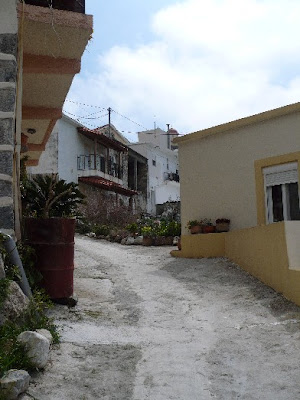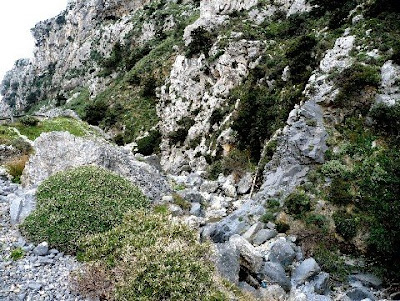 Keith and Christine would love to hear from you with questions, comments, personal news and any news at all from Australia or wherever you are. We will reply to all emails!
Keith and Christine would love to hear from you with questions, comments, personal news and any news at all from Australia or wherever you are. We will reply to all emails! Please write to either
windlechristine@gmail.com or
windle.keith@gmail.com
We heard the rooster crowing and the sheep baaing but, since they are noises we are familiar with, we rolled over and went back to sleep. It was a real pleasure to step out into a beautiful spring morning in the countryside, and to have a little chat with Jo, the pig, the sheep and the cats. Keith startled a large bird which he thought could have been an eagle, in an olive tree.
We went up to the house to use the internet and then set off to explore the area. We remembered that Johannes had said that there was a totally Greek village further up the mountains so we decided to go there.
 Naturally we had failed to ask about which road to take, but we headed up and this turned out to be the right way. On the way we passed a new cheese factory – the one that has been polluting the water upstream so that it is no longer drinkable. A little further on, we came to an enormous water tank, a community collection of rain water from the mountains that Johannes uses when he fills his giant swimming pool. For such a large usage he has to make arrangements in advance.
Naturally we had failed to ask about which road to take, but we headed up and this turned out to be the right way. On the way we passed a new cheese factory – the one that has been polluting the water upstream so that it is no longer drinkable. A little further on, we came to an enormous water tank, a community collection of rain water from the mountains that Johannes uses when he fills his giant swimming pool. For such a large usage he has to make arrangements in advance.
We developed a little system of putting two rocks on top of each other to indicate which way we had come because it would be possible to be seriously lost up here. It was not long before we came to Selia, an enchanting village with all the houses close together in the centre, and some with gardens and fields at the edges, and very steep streets.


 The sound of gushing water led us to an enormous plane tree in the centre of a large paved square, set on the edge of the mountain in a most picturesque spot. At the bottom of the steps to the square, water poured out of the mouth of one intact lion and the remnants of others.
The sound of gushing water led us to an enormous plane tree in the centre of a large paved square, set on the edge of the mountain in a most picturesque spot. At the bottom of the steps to the square, water poured out of the mouth of one intact lion and the remnants of others.
 There was a large area which may be for water storage, difficult to see the need for in winter, but the streams are dry in the summer which can reach 40 degrees centigrade here. Beyond the storage area were the once used communal washing tubs and the glorious view.
There was a large area which may be for water storage, difficult to see the need for in winter, but the streams are dry in the summer which can reach 40 degrees centigrade here. Beyond the storage area were the once used communal washing tubs and the glorious view.
We took a street leading upwards, towards the two churches on the top of the rise. Both churches were closed. I went for a stroll in the cemetery next to the higher and smaller church while Keith sat and enjoyed the sun and the surroundings. Each grave was built up to waist height - a large stone or concrete box with a glass fronted cabinet containing photos of the deceased, icons, flowers and an oil lamp at the head.
 Most lamps were lit. All the writing was in Greek but occasionally dates were understandable. Looking at the faces of the villagers was an intense experience and I imagine that, for children brought to tend graves, it would give a strong sense of connection. When I was a child we visited my grandmother’s grave at Box Hill cemetery and listened to my mother’s stories about her and our other relatives buried there. It would have been such a help to my imagination and feelings back then if there had been photos as well.
Most lamps were lit. All the writing was in Greek but occasionally dates were understandable. Looking at the faces of the villagers was an intense experience and I imagine that, for children brought to tend graves, it would give a strong sense of connection. When I was a child we visited my grandmother’s grave at Box Hill cemetery and listened to my mother’s stories about her and our other relatives buried there. It would have been such a help to my imagination and feelings back then if there had been photos as well.
An older lady dressed all in black, arrived to change the oil in her relative’s lamp and to relight it. All the time she talked and bustled about as if she was doing a regular chore along with someone else.
The village had seemed deserted so far, so catching site of a lady reading in an empty taverna, we decided to stop for a drink. With no common language, Keith asked for two coffees, but with only one spoon of sugar in each (In Greece the coffee usually arrives very sweet with at least two spoons of sugar in it). The result was only one coffee had sugar and the other had none!. It was not a problem so we drank, and I chatted with the lady with the aid of gestures and drawing pictures in my notebook. She was highly amused at my pictures and I felt that I was playing Pictionary as I tried to interpret hers.
 We found the centre of the village and bought some lunch supplies in a charmless, thoroughly modern small supermarket. Taking the long road to Plakias, we set off on the most delightful walk with no pressures, no traffic and no fellow walkers.
We found the centre of the village and bought some lunch supplies in a charmless, thoroughly modern small supermarket. Taking the long road to Plakias, we set off on the most delightful walk with no pressures, no traffic and no fellow walkers.
 We dallied over our picnic lunch just off the road, and finally came to the Kotsifou Canyon. We thought it was the same one we had seen from the bus, but when we left Plakias on the return bus trip, we realised that that one, the Kurtalioti Ravine, was a considerable distance away. No wonder Johannes was amazed when we claimed to have walked to it! There was no way down to the water at that spot so we turned away from Plakias and followed the Canyon along the road up the mountain.
We dallied over our picnic lunch just off the road, and finally came to the Kotsifou Canyon. We thought it was the same one we had seen from the bus, but when we left Plakias on the return bus trip, we realised that that one, the Kurtalioti Ravine, was a considerable distance away. No wonder Johannes was amazed when we claimed to have walked to it! There was no way down to the water at that spot so we turned away from Plakias and followed the Canyon along the road up the mountain.
 We stopped to enter a beautiful tiny church which was built into the rocks. It had spotless and perfectly ironed alter cloths, many burning candles and beautiful icons. Everything was just left open to the public and there was no rubbish, vandalism or graffiti. There is lots of graffiti in urban areas so it does exist here.
We stopped to enter a beautiful tiny church which was built into the rocks. It had spotless and perfectly ironed alter cloths, many burning candles and beautiful icons. Everything was just left open to the public and there was no rubbish, vandalism or graffiti. There is lots of graffiti in urban areas so it does exist here.
 Some birds of prey soared above us as we scrambled down a small cliff into the canyon. There is a very rare bird here – the bearded vulture, but we couldn’t be sure if we were seeing these or eagles constantly gliding close to the level of the clouds which almost permanently hug the mountain peaks. The river was running at the bottom of the steep ravine, with many rocks forming stepping stones and causing little water falls, and some areas banked up as deeper pools. We attempted to walk back at that level but, for every wide gap that Keith could leap across, my short legs required an extensive detour. We could not afford to let our shoes get wet since I only have one pair of walking shoes and Keith only brought one pair. We scaled the slope up to the road and continued our walk, this time taking the way back to Plakias.
Some birds of prey soared above us as we scrambled down a small cliff into the canyon. There is a very rare bird here – the bearded vulture, but we couldn’t be sure if we were seeing these or eagles constantly gliding close to the level of the clouds which almost permanently hug the mountain peaks. The river was running at the bottom of the steep ravine, with many rocks forming stepping stones and causing little water falls, and some areas banked up as deeper pools. We attempted to walk back at that level but, for every wide gap that Keith could leap across, my short legs required an extensive detour. We could not afford to let our shoes get wet since I only have one pair of walking shoes and Keith only brought one pair. We scaled the slope up to the road and continued our walk, this time taking the way back to Plakias.
Plakias is a village with a winter population of about 300 and a summer population of thousands. The streets are lined with accommodation venues, restaurants and tavernas, some literally sitting on the beach. The beach is ideal, clear and sandy, and it is easy to imagine falling in love with the lifestyle and the beauty of the area. We arrived back at the caravan at about 6 pm, having covered about 16 km, satisfied that we had really had a fantastic walk in the countryside.

Clear evidence of rock falls could be found along the roads we walked today. The countryside in much of Crete is extremely rugged.

A common feature of concrete buildings in Greece and in Egypt is the reinforcing steel left protruding in readiness for a future second or third storey, which may never eventuate.
 Keith and Christine would love to hear from you with questions, comments, personal news and any news at all from
Keith and Christine would love to hear from you with questions, comments, personal news and any news at all from 











No comments:
Post a Comment